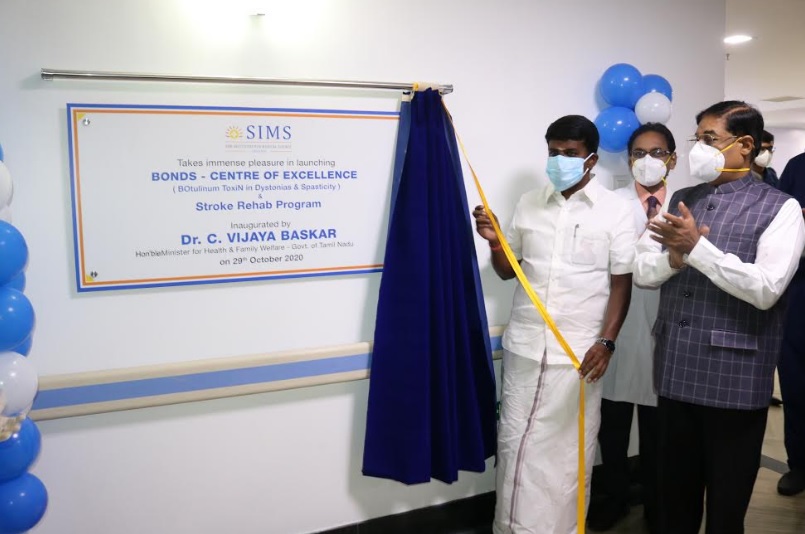Chennai, October 29, 2020
SIMS Hospital (SRM Institutes for Medical Science) one of the leading quaternary care super specialty hospital in Chennai, announced today, the launch of BONDS, (BOtulinum ToxiN in Dystonia & Spasticity), a first of its kind centre in Chennai with focused approach to the treatment of movement disorders like Dystonia and Spasticity (also for Stroke Rehabilitation) using Botulinum Toxin injection at its Vadapalani facility in Chennai.
Inaugurated by Dr. C Vijaya Baskar– Hon. Minister for Health & Family Welfare, Govt. of Tamil Nadu¸ in the presence of Shri. Ravi Pachamuthu – SRM Group, and other dignitaries, the Center of excellence prides of a state-of-the-art facility, complete with a vibrant and skilled team of doctors to handle neurological emergencies in addition to serving chronic patients. The Center is well equipped to offer a wide spectrum of services to treat patients affected by various movement disorders including stroke, dystonia, spasticity and neuromuscular ailments.
Expressing his delight about the launch, Shri. Ravi Pachamoothoo, Chairman, SRM Group, said, “SIMS has always been a proponent of evidence based clinical innovations. ‘BONDS’ Clinic marks yet another milestone in this journey and I congratulate Dr. Meenakshisundarm and his team for setting-up this center of excellence, which I am sure, will bring in significant relief to the people with movement disorders”.
“With such finest clinical talents and resources available in-house, who are always ready to adopt and embrace the latest and highly advanced medical practices, both, effectively and efficiently, we at SIMS will continue to deliver high rates of successful clinical treatments for our patients” he added.
An equally elated, Dr. U. Meenakshisundaram, the Director of the Neurology Department at SIMS Hospital, who is also the present Secretary of the Movement Disorders Society of India and an Executive Committee member of the Indian Academy of Neurology, said, “Clinical research findings have revealed that over last few years the use of Botulinum toxin has shown great results in the treatment of movement disorders and when combined with a proper physiotherapy regimen, people with these conditions recover faster and return to a near-normal life much quickly. Also, administering Botulinum Toxin Injection is a skilled procedure and is done by skilled set of experienced practitioners, complete with progressive monitoring on the patient’s improvement.
“The treatment is done as an outpatient procedure and spans between 3 to 6 months duration with minimal side effects caused due to the weakening of muscles, which are mostly reversible depending on the patient’s medical condition and their response to the treatment”, Dr. Meenakshisundaram added.
A case reference of a successful treatment:
An Indian student in his 20s developed spastic weakness in his left hand and leg due to an infarct in the brain resulting from sudden pulmonary thromboembolism during a skiing accident in South Korea. He was initially treated at a hospital in Japan; after which he was referred to SIMS Hospital for further management of his spasticity. He was evaluated and injected with Botulinum toxin and two weeks later, he had significant relief from the spasticity, thus substantially reducing his disability.
About Botulinum:
Botulinum toxin is like the “villain who turned hero”. It is produced by the bacteria Clostridium Botulinum. Ingestion of this toxin can lead to the deadly disease called botulism. It basically paralyses muscles (and some secretory activity). Science has made use of this feature and has brought in the concept of “controlled paralysis”, wherein only the abnormally excessive unwanted activity is reduced while retaining and supporting meaningful muscle activity.
Although there are many types of toxins produced, only types A and B are used in medical practice (In India, we have only type A available as of now). Neurons or nerve cells communicate with one other and with muscle and other organs through chemicals called neurotransmitters. Botulinum toxin primarily acts by blocking the release of the neurotransmitter acetylcholine. By this way, it helps in relieving unwanted, excessive muscle contraction. In this way, it has been applied to a wide variety of conditions including for cosmetic purposes. In neurology, it is primarily used in dystonias and spasticity apart from conditions such as chronic migraine, hyperhidrosis (increased sweating) and sialorrhea (increased drooling of saliva).
About Dystonia:
Dystonias are a group of disorders which cause abnormal posturing or movements of a body part(s) because some muscle groups go into abnormal, asynchronous contraction. They cause significant disability and discomfort to the sufferers and are in general not very responsive to treatment with oral medications. A common type is the task-specific dystonia where it occurs only with specific tasks such as writing (writer’s cramps), playing musical instruments (such as Piano, Guitar, Mridangam etc.) playing golf or billiards, or counting currency notes.
About Spasticity:
Spasticity is abnormal stiffness that happens in diseases of the brain and/or spinal cord. The stiffness can be pronounced and can cause considerable difficulty in activities of daily living. It can happen in children due to cerebral palsy and other disorders. A common setting is post-stroke spasticity wherein the paralysed limb(s) become stiff over time and cause impediments to further recovery.




